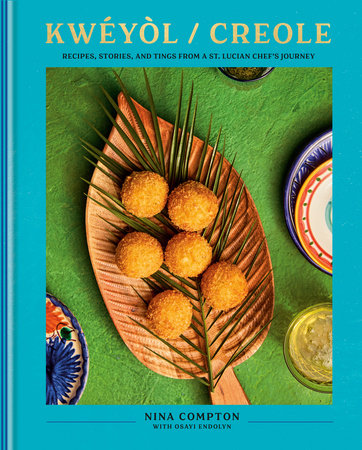IntroductionSa ka fête.
Back home on St. Lucia, any plate of food tells you a story. The characters in that story tell the history of my island. Ground provisions—root vegetables—are the soul of the soil. A typical plate of St. Lucian home cooking features protein like goat or chicken, a salad of lettuces and tomatoes, and always macaroni pie. But the ground provisions, that’s how I know I’m home. Vegetables like cassava were originally used by the Kalinago, our Indigenous people, centuries before Europeans landed in the region. Yams were introduced to the Caribbean through the transatlantic slave trade, with ingredients from historical Senegambia, the Bight of Biafra, and the Gold Coast accompanying the forced movement of people to far-off lands. Breadfruit, a beloved and versatile staple, came to St. Lucia on ships led by enslavers like the infamous Captain Bligh, who transported plantings from Polynesia as a cheap means of sustaining involuntary labor forces. India is a major influence in our layered cuisine, too, brought about by the indentured laborers who arrived after slavery was outlawed in the nineteenth century. They emigrated from the subcontinent, bringing a range of spices and dishes like curry, roti, and dal that remain core aspects of St. Lucian food culture today. The Kalinago used hot peppers not just in their food but as protection. They made a poisonous smoke that caused European colonizers in the early 1600s to die from inhalation or flee into the thick of ready warriors defending their land. Hot peppers today make up our peppa sauce, an indispensable condiment, and throughout the Caribbean, peppers are treated respectfully as protective plant medicine.
St. Lucia is a small country in the Eastern Caribbean, tucked in the center of a crest of islands, just south of Martinique and north of St. Vincent and the Grenadines. What we eat is largely reliant on the season. If it’s not the right time of year for guava or mangoes, you’re not gonna get guava or mangoes. Ground provisions comprise the backbone of most of our meals, foods that sustain and nourish: yam, sweet potato, cassava, breadfruit, plantain, and green fig—what we call green banana. Green fig and saltfish is our national dish. The banana comes from the South Pacific, and salted cod originated in Europe. Enslaved Africans used salted cod to supplement meager diets on island plantations.
These ingredients are the basis of the Creole cooking that I grew up savoring. In St. Lucia when we say “Creole,” we don’t mean French-influenced. That has too often been accepted as the definition in my adopted city of New Orleans, which owes much to West Africa for its cuisine as well. Our Creole, or Kwéyòl, celebrates a diverse African heritage, beautifully reflected in the dishes and customs that shape much of what I eat and how I cook today.
The recipes in this book will introduce you to, or remind you of, traditional and innovative Caribbean cooking. I’m acknowledging the rich history of where I come from, while forging something that feels a little new, a little mine. And now, with this book, a little yours, too. I’m inspired by the flavors I seek out when I go back to St. Lucia. Fresh-caught lobster grilled seaside. The smokiness of pit-roasted breadfruit. Sweet mango dipped in the ocean for a burst of natural salt. The countless possibilities of beloved plantain. Conch fritters. Roti. Callaloo with coconut cream. Guava vinaigrette drizzled over banana. Homemade curry with fresh turmeric and ginger. Pickled mango and avocado salad. Whole roasted fish dressed in green seasoning, a ubiquitous St. Lucian condiment (every island has its own adaptation) made of pureed cilantro and other herbs, spring onions, and garlic.
These dishes incorporate the pivotal stops on my culinary journey, and the book is organized this way—from Moulin à Vent, to Mo Bay, to Miami, and finally New Orleans. As an immigrant in the United States, I am always referencing where I come from, with pride and respect for the traditions that shaped me. And, as a longtime resident of my adopted country, I have been eager to learn, improvise, and enhance the American palate by doing what us transplants do best: We bring home with us wherever we go.
In these pages, the weather is warm and tropical, and the vibe is easygoing, just like the places I’ve lived. The dishes are full of flavor. The mood is chill. We are smiling, sipping rum or coconut water, jamming to music, and whatever is on the stovetop don’t need no fuss. Everything is as it should be, especially when it’s not— because what can you do about it anyway? I love that feeling when I bite into a ripe mango and the juice drips down my arm. It’s the sense of knowing I’m in the right moment, in the right place. Wherever I’m at, I’m home.
Copyright © 2025 by Nina Compton with Osayi Endolyn. All rights reserved. No part of this excerpt may be reproduced or reprinted without permission in writing from the publisher.


















